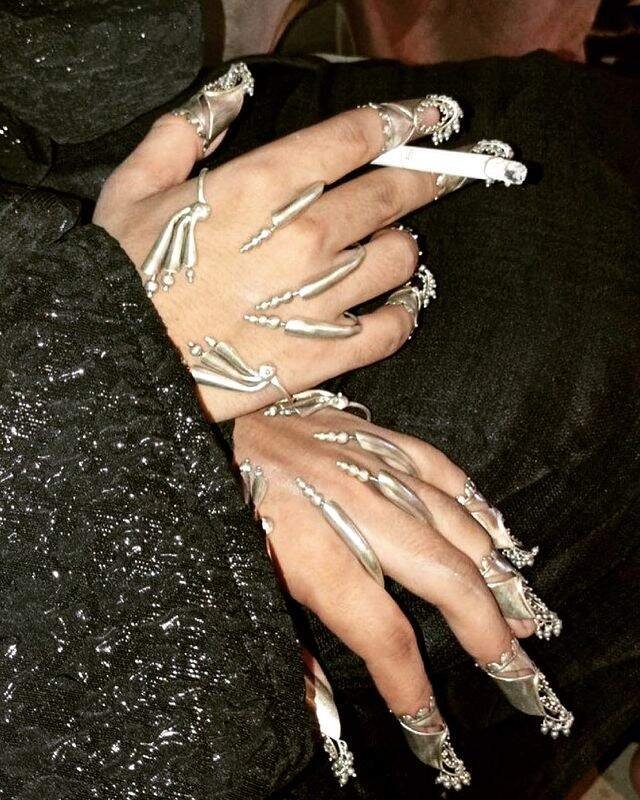Bhavya Ramesh
South Asian, Indian Brand Bhavya Ramesh’s style of jewelry brings the ethnic punk genre to mainstream pop culture. Her fascination with Indian crafts combined with contemporary designs sets a statement of Indian urban culture.
Bhavya my first interest is in wanting to understand your background. How were your childhood and teenage years? Please describe the experiences and settings you were midst growing up.
My family is like any other Indian family and childhood can be called the same. I have grown up in a typical Indian household setup where education has always been the primary focus, not art & craft. When I say education that means doctorate or engineering but me being me I was always drowning in craft, textile, and art.
As a child, I used to visit many art exhibitions and I believe that was the stepping stone in my life that made me fall in love with craftsmanship, and with time the love became an undying passion. I was a studious kid with a love for crafts and I always made time for my craft, candle making, soap making and even collecting different materials to make my dream catchers.
How did you grow a fondness for accessories and jewelry in particular? Please take us through your cultural and social setups. The influences and inspirations.
To be honest I was never fond of jewelry. Jewelry is and has always been a form of wealth for Indian households and for my parents too. Seeing Jewellery only from one perspective that is in form of wealth was quite mundane for me. I always found solace in design as a means of self-expression, so what I have been seeing all my childhood; Jewellery as wealth which became an inspiration in a way, and today if you see my pieces they are a way and form of self-expression and much more.
Did you pursue the craft and design academically? How did crafting happen for you?
I have not persuaded art but I have done a small course of 2 months in design where I learned pattern making and leather crafting and this I have done after finishing my engineering in computer science. I was always intrigued by shapes, forms, textiles, and even architecture. In a way, I began my journey by collecting quirky pieces while traveling and I have spent a great deal of time researching the history and origin of gypsies in northern Karnataka and remote Rajasthan.
Would you like to talk more about the cultural part? The history the background and the overall integrations with the contemporary and modern styling? Please talk about your creative process.
I am a traditionalist and naturalist. Being a part of a diverse and culturally rich country makes you feel proud about the traditions, amazing craftsmanship, art, textile and so much more. As a person, I want to uphold the cultural aspect. Coming out of a traditional family household set up with traditional roots plus a modern thought process is a blend that I want to bring to the world. I am someone who is a traditionalist with a sense of modernism.
My creative process is the same as mine mix thoughts with shapes that lives in my head till the time they evolve organically into beautiful forms which I present in form of my art pieces.
Speaking of the creative process and finalizing ideas and designs. What image do you carry for the consumers you design for?
A brand is an extended form of my love for craftsmanship which means it is a part of me. The intention is to let them self-express and embrace their bold selves but also let them experience design by interacting with it. My jewelry is mechanical pieces beautifully put together forming an interacting piece. The label is always committed to encouraging self-expression, by upholding the power of the human touch by supporting local artisans practicing traditional art forms.
Your work spills the ethnic punk character. How do you dive into the motivations and objectives that govern your overall brand? Please talk about your concerns and related thoughts on the current generation and global & local social issues.
The biggest motivation is self–expression through the new form and shapes and putting them together and creating a collection.
In name of diversity and empowerment brands are making attempts towards hiring minorities to monetize. The word diversity has taken all over the fashion and beauty industry but at the same time, it always feels like tokenism. We are including all diverse body types and faces in editorials and on-ramps. Not sure if we have actually reached the level where we are not following any set standards or if it is just for the time being?
What are your favorite parts of the job you do? What other adjacent roles do you see self-playing in order to get things done?
As always design has been the most therapeutic part of what I do and to make sure whatever I’m going through is expressed. But as a businesswoman, I do feel like there are so many roles one needs to embrace. Management and quality control while scaling up and managing people to bring the best out of them are the most taxing things which I am handling at the moment.
Last but not least who are your recent favorite music artist of Indian ethnicity?
Raveena Aurora and Peter Cat Recording Co.
interview JAGRATI MAHAVER
What to read next














